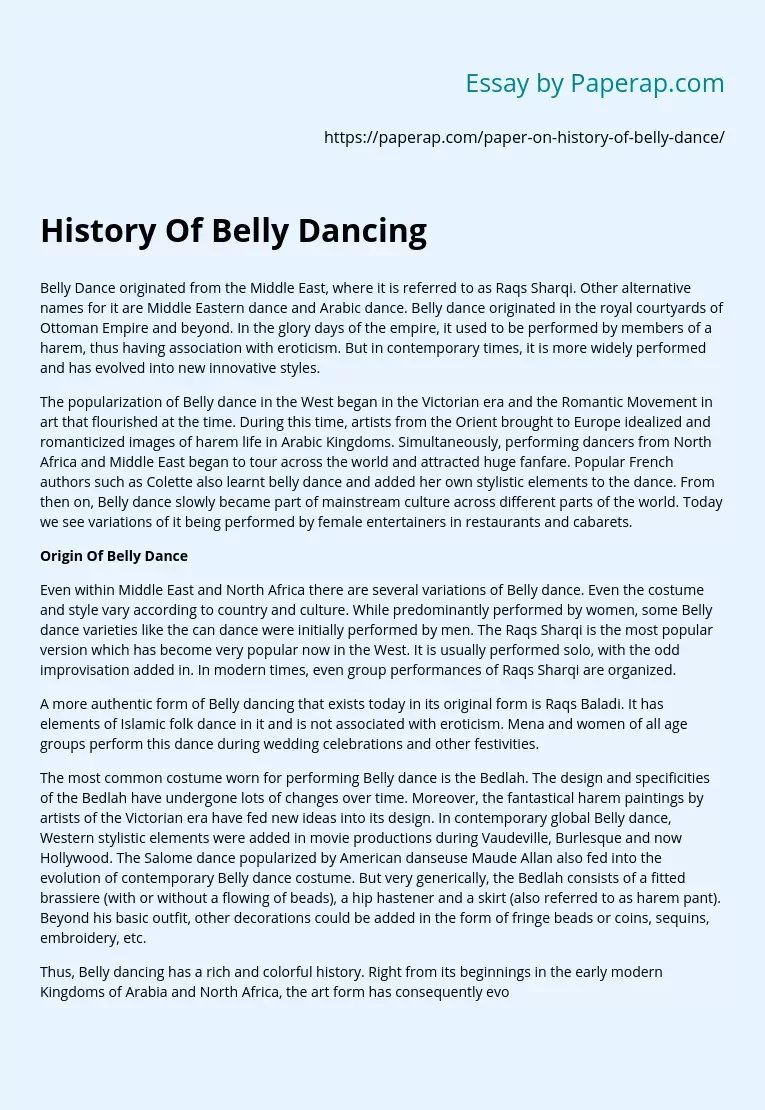Belly Dance originated from the Middle East, where it is referred to as Raqs Sharqi. Other alternative names for it are Middle Eastern dance and Arabic dance. Belly dance originated in the royal courtyards of Ottoman Empire and beyond. In the glory days of the empire, it used to be performed by members of a harem, thus having association with eroticism. But in contemporary times, it is more widely performed and has evolved into new innovative styles.
The popularization of Belly dance in the West began in the Victorian era and the Romantic Movement in art that flourished at the time.
During this time, artists from the Orient brought to Europe idealized and romanticized images of harem life in Arabic Kingdoms. Simultaneously, performing dancers from North Africa and Middle East began to tour across the world and attracted huge fanfare. Popular French authors such as Colette also learnt belly dance and added her own stylistic elements to the dance. From then on, Belly dance slowly became part of mainstream culture across different parts of the world.
Today we see variations of it being performed by female entertainers in restaurants and cabarets.
Origin Of Belly Dance
Even within Middle East and North Africa there are several variations of Belly dance. Even the costume and style vary according to country and culture. While predominantly performed by women, some Belly dance varieties like the can dance were initially performed by men. The Raqs Sharqi is the most popular version which has become very popular now in the West.
It is usually performed solo, with the odd improvisation added in. In modern times, even group performances of Raqs Sharqi are organized.
A more authentic form of Belly dancing that exists today in its original form is Raqs Baladi. It has elements of Islamic folk dance in it and is not associated with eroticism. Mena and women of all age groups perform this dance during wedding celebrations and other festivities.
The most common costume worn for performing Belly dance is the Bedlah. The design and specificities of the Bedlah have undergone lots of changes over time. Moreover, the fantastical harem paintings by artists of the Victorian era have fed new ideas into its design. In contemporary global Belly dance, Western stylistic elements were added in movie productions during Vaudeville, Burlesque and now Hollywood. The Salome dance popularized by American danseuse Maude Allan also fed into the evolution of contemporary Belly dance costume. But very generically, the Bedlah consists of a fitted brassiere (with or without a flowing of beads), a hip hastener and a skirt (also referred to as harem pant). Beyond his basic outfit, other decorations could be added in the form of fringe beads or coins, sequins, embroidery, etc.
Thus, Belly dancing has a rich and colorful history. Right from its beginnings in the early modern Kingdoms of Arabia and North Africa, the art form has consequently evolved to reflect local sensibilities and taste. Today, it continues to be a vibrant source of entertainment, especially directed toward adult men. It is still part of folk culture in Egypt, Lebanon, Turkey, etc, while also making inroads into mainstream American and European culture.
Works Cited:
Coluccia, Pina, Anette Paffrath, and Jean Putz. Belly Dancing: The Sensual Art of Energy and Spirit. Rochester, Vt: Park Street Press, 2005
Hanna, Judith (1988). Dance, Sex and Gender. Chicago: University of Chicago Press. ISBN 0-226-31551-7.
Belly Dance originated from the Middle East, where it is referred to as Raqs Sharqi. Other alternative names for it are Middle Eastern dance and Arabic dance. Belly dance originated in the royal courtyards of Ottoman Empire and beyond. In the glory days of the empire, it used to be performed by members of a harem, thus having association with eroticism. But in contemporary times, it is more widely performed and has evolved into new innovative styles.
The popularization of Belly dance in the West began in the Victorian era and the Romantic Movement in art that flourished at the time. During this time, artists from the Orient brought to Europe idealized and romanticized images of harem life in Arabic Kingdoms. Simultaneously, performing dancers from North Africa and Middle East began to tour across the world and attracted huge fanfare. Popular French authors such as Colette also learnt belly dance and added her own stylistic elements to the dance. From then on.
History Of Belly Dancing. (2019, Dec 05). Retrieved from https://paperap.com/paper-on-history-of-belly-dance/

